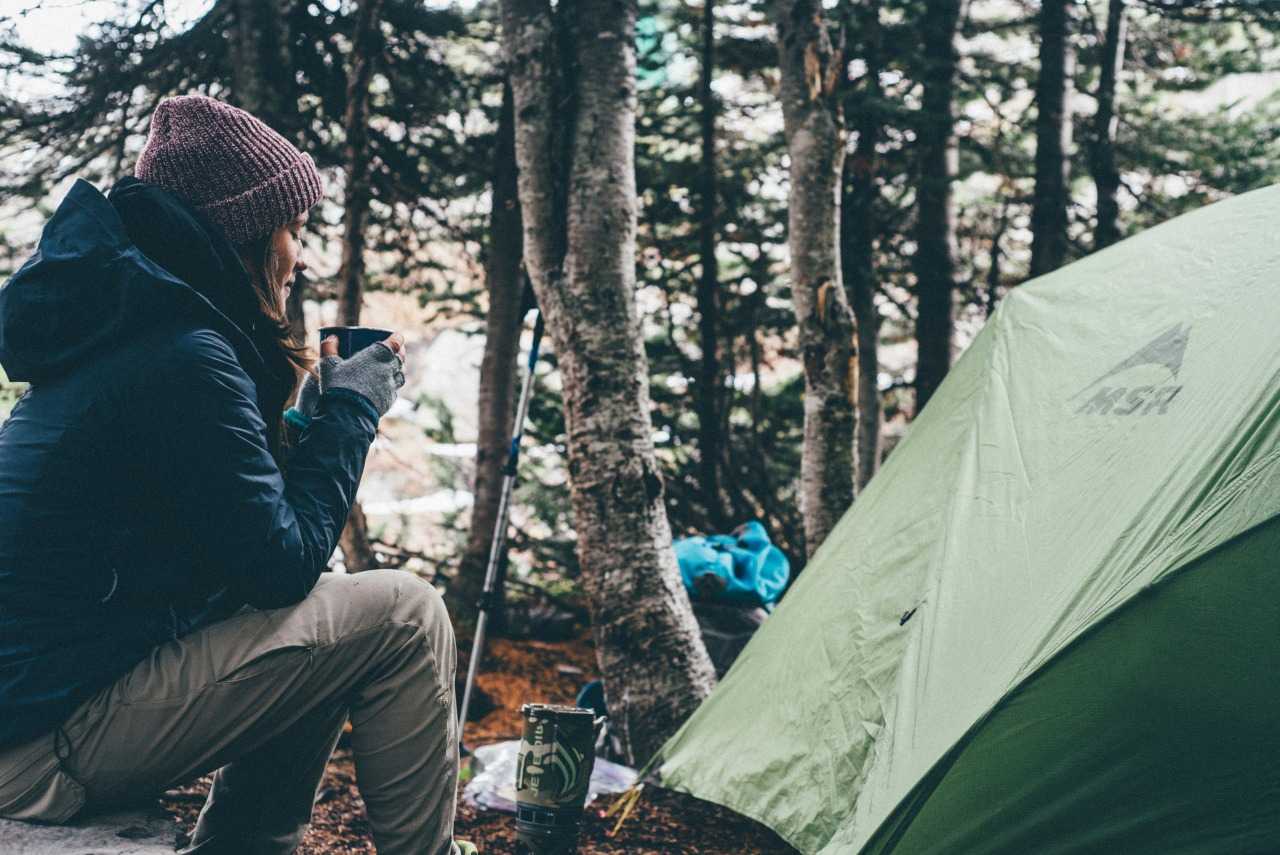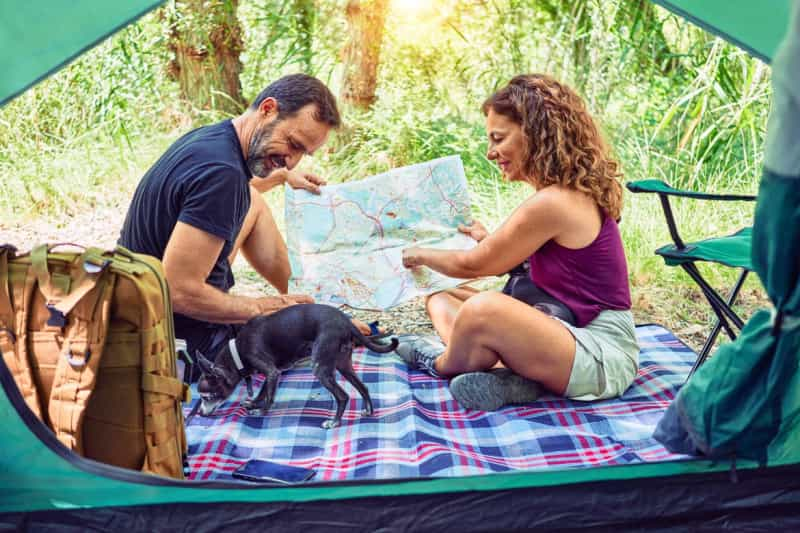Clothes for camping
The correct clothes can easily make or break a camping trip. While you’ll need to wrap up warm for a winter camping trip, camping in hot weather will require lighter, breathable garments. Needless to say, putting together a well-rounded batch of clothes will depend heavily on the type of weather and conditions you’ll be encountering.
No matter the time of year, there are some essential garments that you’ll want to include in your camping checklist and other items that are strictly a no-go. With these top tips for packing for a camping trip, you’ll be prepared to travel light but still be well equipped for all eventualities and ready to relax in the fresh air.

Top tips when packing for a camping trip
1. Keep it light.
The first rule of packing for a camping trip is to stick to the essentials and avoid going overboard on the wardrobe changes. Remember, you’ll need to carry your clothes from the car to the pitch or between campsites. Tally up the days you’ll be camping, how many activities you’ll be doing (particularly any ones where you might get dirty) and work out how many outfit changes you’ll need.
2. Select two sturdy pairs of shoes.
Shoes are among the heaviest items to pack, so we’d recommend bringing one pair of walking boots and one lightweight pair of trainers for lighter activities and lounging around the campsite. You may also want to pack a pair of flip flops or sandals for the campsite showers or the beach.
3. Pack according to the weather forecast.
If rain is predicted, waterproof layers and shoes are a must. If there’s snow, you’ll need a good winter coat and lots of layers. If you’re going to be camping in a heatwave, prioritise breathable, lightweight clothes and a few layers for the colder nighttimes.

Above all, though, it’s important to remember that weather is never fully predictable, even from the professional forecasters, so keeping a waterproof jacket as a backup is always a good idea.
4. Consider bringing a small bottle of laundry detergent.
One way to keep down the number of garments you bring is by packing a small bottle of laundry detergent. That way, you’ll be able to re-use worn clothes by giving them a wash under your campsite’s tap (check in advance that they have one) or by using any available launderette facilities.
5. Be smart about the outfit you wear to and from the campsite.
Once you’ve narrowed down your essential items, put aside an outfit for your journey to and from the campsite – and be smart about it. Don’t fall into the trap of wearing your favourite jeans, which are likely to be left untouched for most of your stay. Trousers or leggings and a sweat-wicking T-shirt and jumper are a smart outfit choice, as they can be re-worn.
Just bear in mind that the clothes you wear might get a little dirty when you’re setting up your tent.
What type of clothes should you wear camping?
1. A waterproof jacket
Without a waterproof jacket, your clothes will quickly get soaked through if the storm clouds roll over. Waterproof jackets should have a breathable waterproof membrane (nylon or polyester) or a laminate covering (typically made out of polyurethane or Teflon) to repel water away from your torso effectively.
2. Quick-dry T-shirts
Instead of your normal cotton T-shirts, pack a bunch of quick-dry T-shirts. They’re usually made from 100% polyester or nylon, which is quicker to recover from rain, sweat and any impromptu wild swims. They’ll usually be labelled as ‘sweat wicking’ and produced by sports or outdoor clothing brands.
3. Long-sleeved tops and trousers
Long-sleeved tops and trousers have three main benefits: they’re easy to layer up, they protect against sunburn and they reduce the chances of insects such as mosquitos, ticks and mites biting you.
4. Extra layers such as a fleece or warm jumper
The weather is notoriously unpredictable and temperatures always drop at night, so extra layers such as a warm fleece or jumper are easy to put on or peel off depending on the climate.
5. Dry, warm layers at night
If you’ve been camping before and made this mistake, you’ll know that tucking yourself into bed under canvas in damp clothes is a recipe for a sleepless night. Always pack and store clean, dry clothes specifically for bedtime, including a few layers in case it’s cold.
6. Underwear and socks
Any trip without underwear or socks is likely to be an unhappy one, so before you set off, you’ll want to add up how many days you’re away for and bring at least one or two pairs of socks and underwear for each day. We recommend bringing spares, just in case they get wet or muddy or they’re misplaced, and accounting for any outdoor activities that will require a complete change of clothes.
7. Walking boots
It’s likely you’ll be doing some form of walking or hiking on your camping trip, so proper ankle support is key, especially if you’re traversing rocky landscapes. Well-fitting and sturdy walking boots, preferably already broken in to avoid any unnecessary blisters, are preferable to trainers.
8. A pair of trainers for around the campsite
When you’re not out hiking, you’ll need a lighter-weight, but still sturdy, pair of trainers to fall back on. Check the terrain of your campsite before you set off; if it’s particularly muddy, you might want to opt for a pair of wellies instead.
9. A small backpack
A small backpack on your biking trips, hikes or days out will be far more comfortable than any carrier bag or handbag, so don’t forget to slip one in your luggage.
10. A suitable hat
Whether it’s a sun hat or a woollen hat, these items are always handy to have on hand to protect yourself from wind, sun or snow or keep your extremities warm (such as your ears).
What should you not wear when camping?
1. Flip flops
Even if you’re planning the laziest of beach holidays, we’d recommend choosing a sturdy pair of sandals over flip flops. Not only are they more comfortable, but they’re also safer; flip flops offer little protection from hard rocks, thorns and bugs on the ground. The only time they might come in handy is for any campsite showers.
2. Denim
Denim will soak up moisture very quickly, and once it’s wet it’ll quickly weigh you down. Jeans also take a long time to dry and have little effect in wicking away sweat.
3. Cotton
While it’s not nearly as bad as denim, cotton lacks the breathability and moisture-wicking properties that nylon and polyester clothing has, so if you have the choice, we’d recommend the latter.
4. Jewellery
Jewellery such as earrings, necklaces and bracelets are easy to catch on things. They’re also easy items to damage, lose or misplace. Thieves may quickly detect shiny items as an invitation to target your tent, so leave them behind to keep you and your valuables safe on a camping trip.
5. Socks and sandals
Sandals are all about breathability. Socks, on the other hand, are designed to keep your feet warm and cosy. Socks should be paired with trainers or boots to keep your feet warm and sandals reserved for the beach or lounging around, because they offer less protection from the elements.
6. Offensive clothing
It’s likely you’ll be sharing a campsite with other guests and children, so naturally, any offensive clothing items should be left behind. This includes violent or sexual images, offensive wording and walking around in the nude (unless you’re visiting a designated naturist campsite).
7. Expensive or sentimental clothes.
The clothes you take camping could succumb to any of the following: mud, tears, grass stains or general wear and tear. So, it’s a good idea to leave any near and dear items or expensive clothes safe in your wardrobe at home.
8. Light or white clothes.
Light or white-coloured clothes will easily pick up stains. Pack darker clothes to mask dirt or other stains.
9. Perfume
Perfume, especially flowery or sweet scents, should be avoided for a bug-free camping trip.
Now that you’re well-dressed and properly prepared for your camping trip, check out our ultimate tent camping checklist and other camping guides so that you properly unwind without any unnecessary hassles.
Browse our ultimate guide to camping

